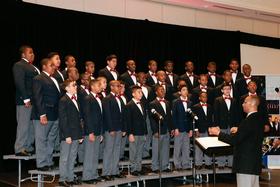Charter schools fit in a niche between private and public schools. They are funded with public money (except for their facilities) and they are an alternative to regular public schools systems. A private group of people can submit an application for and get approval for a charter to run their own school. Charter schools receive waivers from public school districts in exchange for promising better academic results. Charters are usually given three to five years to demonstrate academic achievement, during which time officials monitor students’ academic performance. If academic performance lags behind comparable public schools, then the charter is pulled and the school is closed.
This video explains what charter schools are, through testimonials from charter school parents, students and leaders.
Since the Minnesota legislature passed a law creating the first charter school in 1991, charter schools have seen an enormous increase in number to over 5,300 by 2011. By the 2010-2011 school year, charter school legislation had passed in 41 states and Washington, D.C. This phenomenal increase in the number of charter schools proves that it is an educational innovation that is not confined to reforming existing schools but is also an avenue by which new schools can be created. Chartering gives schools the freedom to tailor programs that are reflective of the community needs. Chartering also allows the school to run autonomously of the existing public school system. Parents and educators are looking at chartering as a way to increase educational choice and innovation within the public school system.
In this article, we will look at the history of charter schools, learn more about how charter schools are developed, find out some basic facts about charter schools today, look at both pros and cons for charter schools, and learn what to consider when evaluating charter schools for your family.
History
The formation and history of charter schools can be traced to reform ideas, from alternative schools to site-based management, magnet schools, public school choice, and privatization. The concept of “charter” schools originated in the 1970s and is generally credited to New England educator Ray Budde. Budde suggested that groups of teachers be given contracts or “charters” by their local school boards to explore new approaches. Albert Shanker, former president of the American Federation for Teachers, also receives credit for helping move the charter school concept along in the late 1980s.
The late 1980s also saw schools-within-schools in Philadelphia, which were called “charters”. When the experiment was successful, districts in other areas refined their approach and tried it themselves. In a similar endeavor in Minnesota, educators developed charter schools with three basic values: opportunity, choice, and responsibility for results. Minnesota passed a charter school law in 1991. California passed similar legislation in 1992. Enjoying wide support, charter schools are now one of the fastest growing innovations in education policy.
For his proposed budget for 2006, President George Bush asked for $219 million dollars in grants for 1,200 new and existing charter schools. He also asked for $50 million for a Choice Incentive Fund for an innovative voucher system that would allow parents to transfer their students to other public, private, or charter schools. Bush also asked for $37 million to help charter schools to help them obtain the needed credit to renovate, lease, or buy school facilities. While charter schools receive state and local money to help with operations, they do not receive money for their facilities.
President Obama has continued the Executive Branch’s support of charter schools. In 2009, his administration revised the School Improvement Grants program and created the Race to the Top Program, an initiative that seeks to transform underperforming public schools into charter schools. Yet, charter school funding still lags behind funding for traditional public schools. On average, charter schools receive 70% of the funding public schools receive.
What are Charter Schools?
Charter Schools are schools of choice: choice to parents, students, teachers, and administrators. Parents and students get to choose to enroll in a school that may offer a unique learning environment, such as a school whose science classes are conducted in the field, or offer alternative learning methodologies, such as a specialization in arts education. Teachers and administrators have more authority to make decisions than most traditional public schools. Basically, these schools are free from many of the regulations that apply to traditional public schools.
Charter schools tend to be small schools, with a median enrollment of 242 students as compared to 539 in traditional public schools. According to the Mackinac Center for Public Policy, the average charter school instructor has 19.8 students in his or her classroom, as compared to an average of 21.3 kids for public school teachers. Charter schools also serve different communities with a wide variety of curricular and instructional practices.
This video from the Los Angeles Times explains how charter schools function.
Charters are granted for a particular period of time, usually for three to five years, which are renewed after the end of the term by the granting entity if performance targets are achieved. A charter is a performance contract that provides details about that school’s mission, program, goals, students served, methods of assessment, and ways to measure success – a business plan so to speak. These schools are under constant pressure to perform well, as they are accountable to their sponsor, usually a state or local school board, for good academic results. The charter school administration must adhere to their charter contract, but charter schools enjoy greater autonomy in return for accountability. Instead of being asked to comply with various rules and regulations, they are measured on the yardstick of academic results and adherence to their charter.
Charter schools have shown promising, but mixed results over the years. Though more data is needed to get the overall picture, the performance of charter schools seems to be similar to that of public schools: some do very well, others perform poorly, but most are somewhere in between. On one hand, there are success stories where some charter schools receive renewals of their charters because they met the goals of their charter, while there are also schools whose charters have been revoked due to lack of proper financial management or lack of adequate student achievement.
How Charter Schools Work
In order for a charter school to work, they must have the following: a) the proper state legislation, b) a group of administrators to run the charter school and c) a state authorized managing entity (usually a board). To open a charter school, the administrators must first submit a charter school proposal to their state’s charter authorizing entity, which varies from state to state depending on the state’s charter law. Generally, four types of entities authorize charter schools: the local school board, state universities, community colleges, and the state board of education.
To better understand what a charter school is, one must examine what lawmakers seek to do by drafting charter school laws. In most states, lawmakers want to:
- Increase opportunities for learning and provide access to quality education for students.
- Create a choice for parents and students within the public school system.
- Provide a system of accountability for results in public education.
- Encourage innovative teaching practices.
- Create new professional opportunities for teachers.
- Encourage community and parent involvement in public education.
- Leverage improved public education.
The variation that can be seen in charter schools is because of two primary reasons. First, it can be because charter schools have unique missions and goal statements. Second, states have different charter laws, which have an impact on the development and governance of charter schools. Information from the U.S. Department of Education states that U.S. Charter School laws cover seven basic policy and legal areas:
- Charter Development: Who may propose a charter, how charters are granted, the number of charter schools allowed, and related issues.
- School Status: How the school is defined in terms of related governance, operations, and liability issues.
- Fiscal: The level and types of funding provided and the amount of financial independence and autonomy.
- Students: How schools are to address admissions, non-discrimination, racial/ethnic balance, discipline, and special education.
- Staffing and Labor Relations: Whether the school may act as an employer, what labor relations laws apply, and other staff rights and privileges.
- Instruction: The degree of control a charter school has over the development of its instructional goals and practices.
- Accountability: Whether the charter serves as a performance-based contract, how assessment methods are selected, and charter revocation and renewal issues.
Facts about Charter Schools
Admissions policies
The law states that all the charter schools must conduct fair and open admissions, and recruit all segments of the community they serve. However, problems arise when the number of students seeking admission is more than the number that can be admitted. In this scenario, many charter schools use a lottery system or keep waiting lists. The school charter will usually state explicitly how their registration process will be undertaken. Some charters will give preferential enrollment to the following:
- Children of teachers or other employees of the school;
- Students who have previously been enrolled at the school;
- Siblings of current or former students;
- Children that are considered to be academically at-risk;
- Children of color, in order to reflect the racial/ethnic balance of the regular public schools in the area.
Where are Charter Schools?
According to the National Center for Education Statistics (NCES), the 5,300 charter schools operating in the United States in 2011 were spread throughout the country. California, with 364,000 students in charter schools, has by far the largest charter school enrollment of any state. As a percentage of public school students, Washington, D.C. has the highest charter school enrollment, with 38 percent of students attending a charter school. Arizona and Texas also have large numbers of students attending charter schools. According to the NCES, charter school legislation has yet to pass in Alabama, Kentucky, Montana, North Dakota, South Dakota, Vermont, Nebraska, West Virginia, and Washington. While Maine has passed a charter school law, no charters are yet open in that state. The remaining 40 states that have passed charter laws currently have charter schools in operation.
In this video, Eva Moskowitz, founder of Success Academy Charter Schools in New York City, discusses how she got involved in education reform, and how her schools manage to consistently outperform schools serving similar demographics in the city and across the country.
Demographics
Charter schools have similar demographic characteristics as compared to public schools. However, because of the freedom that charter schools have in terms of curriculum development and general oversight of the school, there are schools in some states that serve populations that are skewed. For example, some urban schools have significantly higher percentages of minority or economically disadvantaged students than traditional public schools. Some school charters stipulate that their racial/ethical breakdown may not deviate from the breakdowns in public schools within the same school district. In that case, the charter school can enroll students preferentially, so as to get the target racial/ethical breakdown. Yet other charter schools have a greater percentage of high performing students than their public school counterparts or a disproportionately low number of special needs students. These differences can be attributed to the types of academic programs offered at some charter schools.
Tuition
Charters are not allowed to charge tuition but are instead and funded according to the number of students enrolled, just like public schools are. States such as Alaska, Colorado, Minnesota, and New Jersey, receive less than 100% of the funds allocated to their traditional counterparts for the operation of public schools. In other states, like California, additional funds or loans are made available to them. In most states, charters do not receive capital funds for facilities. They are entitled to federal categorical funding for which their students are eligible, such as Title I and special education monies. Federal legislation provides grants to help charters with start-up costs.
Advantages of Charter Schools
The primary advantage of charter schools can be summed up in a word: choice. Students and parents get numerous educational options from charter schools that may not be available in local public schools. Charter school supporters argue that even for students who don’t attend the charter schools, their experience will benefit from the existence of charter schools as they force traditional schools to improve their academic programs in order to compete for students to fill their seats. Proponents believe that if managed properly, charter schools can serve as laboratories for educational experimentation and innovation. The easing of certain regulations can free teachers and administrators to develop and implement new curricular experiences and try out new learning strategies. At the very least, the pressure to perform means that charter schools have to perform well or face closure. This extra incentive certainly impacts the teaching environment at charter schools.
Disadvantages
Opponents find fault in the fact that charter schools operate as a business in addition to a learning institution. According to critics, charter schools are subject to market forces and can be driven to close and deprive students of continuous education. Additionally, some critics maintain that charter schools segregate students along the racial and class lines and that they may also fail to adequately serve students with disabilities or limited English proficiency.
Teacher unions have voiced opposition against the charter school movement as well. According to a report by the National Center for the Study of Privatization in Education, because charter schools operate independently of public school systems, they aren’t subject to certain requirements, such as having classroom teachers that are certified by the state board of education. Critics additionally charge that since they do not receive the same level of funding as a traditional public school, charter schools can have inadequate facilities, supplies, and other vital resources. A further concern from teachers is that charter schools can demonstrate greater inequality by not admitting some students based on their income level, ability level or other such factors.
School Visit: Things to Look For and Questions to Ask
If you are considering enrolling your child at a charter school, you need to consider some questions before you even visit the school. For example,
- Where is it located? Is the distance feasible for your family?
- How many years has the school been operating under its charter?
- Does the school have a track record of showing academic progress?
- What teaching methodology does the school embrace?
- What is the procedure for enrolling students?
If you decide that a charter school might be feasible for your family, plan a visit to the school campus. For your visit make sure that you get to meet the principal and a few teachers. Arrange for a tour of the school to get a feel for its facilities. Look around classrooms and examine the quality and quantity of textbooks, technology, and supplies. Finally, school officials should make the following important details very clear:
- The educational philosophy or mission;
- The procedures regarding student discipline and safety;
- How student progress is encouraged and monitored;
- Library resources, including technology for student use;
- Use of technology to support teaching and learning in the classroom;
- Available extracurricular and enrichment activities such as music, the arts, student clubs and organizations, sports and other activities;
- Transportation policies and procedures;
- Policies to support students with academic, social or emotional difficulties;
- Strategies used to teach students who are not fluent in English;
- Professional development opportunities for teachers;
- Academic progress compared to requirements set forth by the charter.
To get complete knowledge about the school, you should observe details like:
- Do teachers seem enthusiastic and knowledgeable, asking questions to keep the interest of the students and keep them engaged?
- Does the principal seem confident and interested in interacting with students, teachers, and parents?
- How do students behave in class, in the halls and in other common areas around the campus?
- How well are the facilities maintained?
Apart from these general questions, be sure to ask these charter-specific questions as well:
- Why was this school created?
- Is this the permanent location or facility for the school? If not, will the school be moving to another location in the near future?
- Does the school have a specific curricular focus?
- Who is the charter holder, or the group that created the school?
- How does the school select its teachers? Are the teachers certified?
Conclusion
Charter schools are public schools of choice, chosen by teachers and students. They have the advantage of enjoying freedom from many regulations that apply to traditional public schools. Generally, these schools give more authority to teachers and students to make decisions. Instead of being accountable for compliance with rules and regulations, they are accountable for academic results and for upholding their charter.
This freedom has given charter schools certain advantages. They have the independence to try new forms of teaching and to experiment with the best way to reach their students. They also avoid a myriad of challenging government regulations and the interference of state officials. However, there are some disadvantages to this freedom. Charter schools treat education as a product; they may not help all students as admission requirements, transportation costs, and limited information can prevent disadvantaged students from attending a charter school.
To get more information on charter schools operating in your area, consult the National Charter School Directory published by the Center for Education Reform. The directory provides contact information and profiles of charter schools nationwide.
Questions? Contact us on Facebook. @publicschoolreview



















































































































































